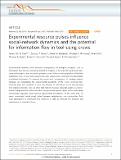Files in this item
Experimental resource pulses influence social-network dynamics and the potential for information flow in tool-using crows
Item metadata
| dc.contributor.author | St Clair, James | |
| dc.contributor.author | Burns, Zackory | |
| dc.contributor.author | Bettaney, Elaine | |
| dc.contributor.author | Morrissey, Michael Blair | |
| dc.contributor.author | Otis, Brian | |
| dc.contributor.author | Ryder, Brandt | |
| dc.contributor.author | Fleischer, Robert | |
| dc.contributor.author | James, Richard | |
| dc.contributor.author | Rutz, Christian | |
| dc.date.accessioned | 2015-11-04T13:10:02Z | |
| dc.date.available | 2015-11-04T13:10:02Z | |
| dc.date.issued | 2015-11-03 | |
| dc.identifier | 181719526 | |
| dc.identifier | e64929d1-e0b5-4835-be9b-1137425b08b1 | |
| dc.identifier | 84946205162 | |
| dc.identifier | 000366285400001 | |
| dc.identifier.citation | St Clair , J , Burns , Z , Bettaney , E , Morrissey , M B , Otis , B , Ryder , B , Fleischer , R , James , R & Rutz , C 2015 , ' Experimental resource pulses influence social-network dynamics and the potential for information flow in tool-using crows ' , Nature Communications , vol. 6 , 7197 . https://doi.org/10.1038/ncomms8197 | en |
| dc.identifier.issn | 2041-1723 | |
| dc.identifier.other | ORCID: /0000-0001-5187-7417/work/60427550 | |
| dc.identifier.uri | https://hdl.handle.net/10023/7739 | |
| dc.description | The project was funded by the Biotechnology and Biological Sciences Research Council (David Phillips Fellowship to C.R.: grant numbers BB/G023913/1 and /2), with contributions for genetic analyses by the Smithsonian Conservation Biology Institute’s Center for Conservation and Evolutionary Genetics. | en |
| dc.description.abstract | Social-network dynamics have profound consequences for biological processes such as information flow, but are notoriously difficult to measure in the wild. We used novel transceiver technology to chart association patterns across 19 days in a wild population of the New Caledonian crow—a tool-using species that may socially learn, and culturally accumulate, tool-related information. To examine the causes and consequences of changing network topology, we manipulated the environmental availability of the crows’ preferred tool-extracted prey, and simulated, in silico, the diffusion of information across field-recorded time-ordered networks. Here we show that network structure responds quickly to environmental change and that novel information can potentially spread rapidly within multi-family communities, especially when tool-use opportunities are plentiful. At the same time, we report surprisingly limited social contact between neighbouring crow communities. Such scale dependence in information-flow dynamics is likely to influence the evolution and maintenance of material cultures. | |
| dc.format.extent | 8 | |
| dc.format.extent | 1518031 | |
| dc.language.iso | eng | |
| dc.relation.ispartof | Nature Communications | en |
| dc.subject | QH301 Biology | en |
| dc.subject | NDAS | en |
| dc.subject | BDC | en |
| dc.subject | R2C | en |
| dc.subject.lcc | QH301 | en |
| dc.title | Experimental resource pulses influence social-network dynamics and the potential for information flow in tool-using crows | en |
| dc.type | Journal article | en |
| dc.contributor.sponsor | BBSRC | en |
| dc.contributor.institution | University of St Andrews. School of Biology | en |
| dc.contributor.institution | University of St Andrews. Centre for Social Learning & Cognitive Evolution | en |
| dc.contributor.institution | University of St Andrews. Centre for Biological Diversity | en |
| dc.identifier.doi | 10.1038/ncomms8197 | |
| dc.description.status | Peer reviewed | en |
| dc.identifier.grantnumber | BB/G023913/2 | en |
This item appears in the following Collection(s)
Items in the St Andrews Research Repository are protected by copyright, with all rights reserved, unless otherwise indicated.

